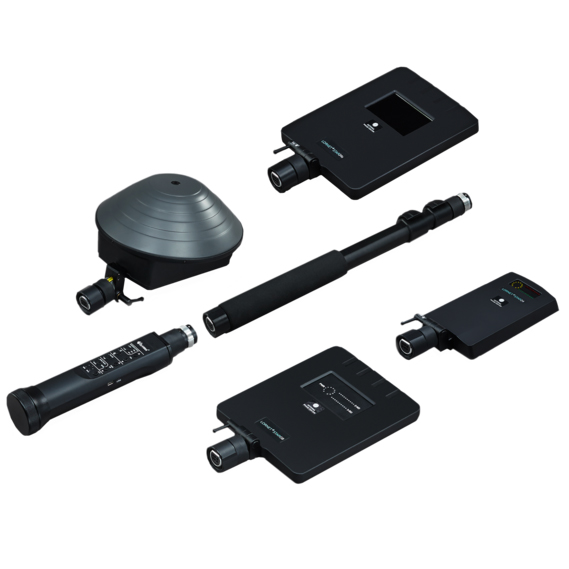Description
LornetStar - the world's only non-linear junctiondetector featuring an integrated spectrum analyzer of 2nd and 3rd harmonics andinterchangeable transmitter-receiver unit of 3 frequency bands: 800 MHz, 2400MHz and 3600 MHz.
Forefficient identification of artificial and natural semiconductors a visualspectrum analyzer or a listening through a built in speakerphone or headphonesafter AM or FM decoding of the signal in continuous mode is used.
Key features
l operation in absorbing mediawith high humidity
l detection of small semiconductorelements and remote detection with spatial selection of target
l reliable detection of SIM-cardat a distanse of 10-15 cm
l universal control unit withreplaceable recieving/transmitting units and extension rod
l built-in spectrum analyzer of2nd and 3d harmonics increses identification efficiency of semiconductorelements (for 800 and 2400 MHz)
l vivid and explicit indication ofpower levels of the signal and the received harmonic-waves
l automatic protection systemagainst centered jamming by criterion of a minimum noise in the receiver pathof the 2nd harmonic
l user friendly interface andunified push-button control. It does not require pre-setting before the start
l electromagnetic radiationtowards the operator is many times less than one set by the Regulator
Main Competitive Advantages
l Does not have analogues in theworld.
l The operator can analyze notonly the amplitude, but also the spectra of 2nd and 3rd harmonics signalsre-emitted by a non-linear object, relative to probing frequency, whichincreases informational content of the non-linear features of the object. In particular,that considerably facilitates decision-making on the separation of corrosiveand artificial semiconductors.
l There is a built-in modulemeasuring the reflected power of the probing signal from the research object,which allows it to estimate the extent of the reflecting surface of the object.
l Use of 3 replaceabletransmit/receive units significantly reduces the probability of missing a thingat search operations providing major advantages in all three ranges:
l 800 MHz - all-weather andrelatively low attenuation of signals in dense medium (brick, concrete, etc.),
l 2400 MHz - the opportunity todetect SIM cards and small (about 1 cm?) semiconductor devices,
l 3600 MHz - providing spatialselection, which facilitates search operations in premises containing legalelectronic devices.
l Time to replace transmit/receiveunits and extension rod will not exceed a few minutes.
Technical Characteristics
l Replaceabletransmit/receive blocks provide probing signal frequency in the range:
2400MHz,
800 MHz,
3600MHz.
l Typesof probing signal:
pulse(with relative pulse duration 44),
continuous(with AM demodulator),
continuous(with FM demodulator).
l Outputpower of pulse (continuous) signal at least 10 (0,3) W.
l SpectrumAnalyzer at the 2nd and 3rd harmonics of probing signal in the band of 10 kHzand a resolution of 40 Hz.
l Sensitivityfor 2nd and 3rd harmonics at least -110 dBm (-140 dBW).
l Dynamicindication range of 2nd and 3rd harmonics more than 40 dB.
l Indicationof re-emitted signals of the 2nd and 3rd harmonics.
l Removableextension rod.
l Manualpower adjustment in the range of 20 dB.
Antenna module | 08 | 08s | 24 | 24s | 36m |
Frequency of probing signal in the range | 800 MHz | 800 MHz | 2400 MHz | 2400 MHz | 3600 MHz |
The maximum power of the probing signal (max. // average): | |||||
Pulse mode | 10W//230mW | 10W//230m W | 10W//230mW | 10W//230mW | 18W//112mW |
Continuous mode | 300mW | 300mW | 300mW | 300mW | - |
Pulse mode with low off-duty factor (CW) | - | - | - | - | 6W//375mW |
Receiver sensitivity | -110dBm(-140dBmW) | ||||
Probing signal power adjustment range | 20dBm | ||||
Receiving path dynamic range | 24dBm | ||||
Battery life at maximum power in a pulse (continuous) mode | 3,0h (1,5h) | 3,0h (1,5h) | 3,0h (1,5h) | 2,5h (1,5h) | 2,5h (1,5h) |
Module dimensions | 102х16х6cm | 102х16х6cm | 39х10х6cm | 39х10х6cm | 47х32х19cm |
Telescopic rod sizes | 54x4x4 (86x4x4)cm | ||||
Full weight of the device without telescopic rod | up to1,5 kg | ||||
Telescopic rod weight | 0,2 kg | ||||
Bag dimensions | 65x30x20cm | ||||
Maximum device weight in the bag | 3kg | ||||
Operating temperature range | from +5°C to +40 °C | ||||
Possible modifications
Lornet Star 08 - with antenna module for 800 MHz
Lornet Star 08s - with antenna module for 800 MHz and spectrum analyzer
Lornet Star 24 - with antenna module for 2400 MHz
Lornet Star 24s - with antenna module for 2400 MHz and spectrum analyzer
Lornet Star 36m - with antenna module for 3600 MHz
Lornet Star 08/24 - with 2 antenna modules for 800 MHz and 2400 MHz
Lornet Star 08s/24 - with 2 antenna modules for 800 MHz withspectrum analyzer and 2400 MHz
Lornet Star 08/24s - with 2 antenna modules for 800 MHz and 2400 MHz with spectrumanalyzer
Lornet Star 08s/24s - with 2 antenna modules for 800 MHz and 2400 MHz with spectrumanalyzers
Lornet Star 08/36m - with 2 antenna modules for 800 MHz and 3600 MHz
Lornet Star 08s/36m - with 2 antenna modules for 800 MHz withspectrum analyzer and 3600 MHz
Lornet Star 24/36m - with 2 antenna modules for 2400 MHz and 3600 MHz
Lornet Star 24s/36m - with 2 antenna modules for 3600 MHz and 2400MHz with spectrum analyzer
Lornet Star 08/24/36m - with 3 antenna modules for 800 MHz, 2400 MHz and 3600 MHz
Lornet Star 08s/24/36m - with 3 antenna modules for 800 MHz with spectrum analyzer, 2400 MHzand 3600 MHz
Lornet Star 08/24s/36m - with 3 antenna modules for 800 MHz, 2400 MHzwith spectrum analyzer and 3600 MHz
Lornet Star 08s/24s/36m - with 3 antenna modules for 800 MHz and 2400MHz with spectrum analyzers and 3600 MHz

